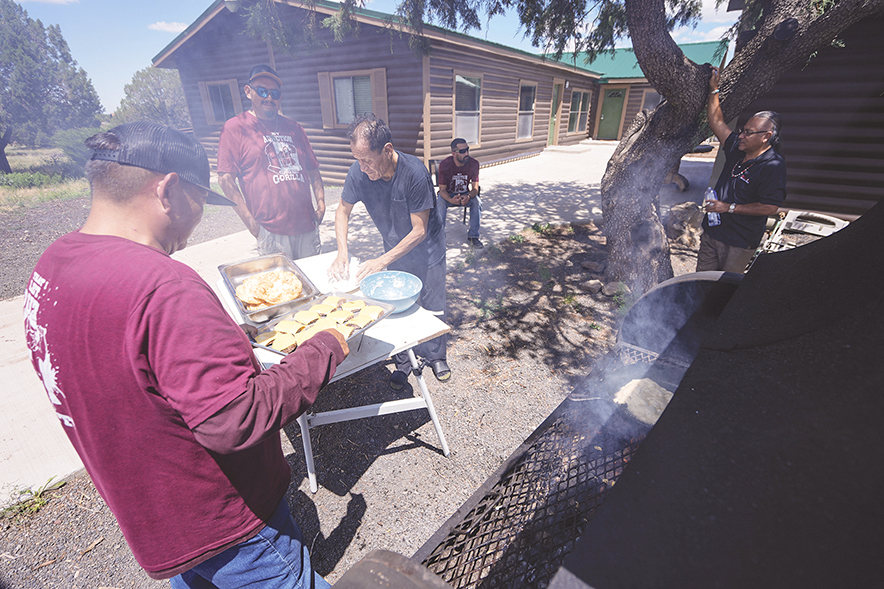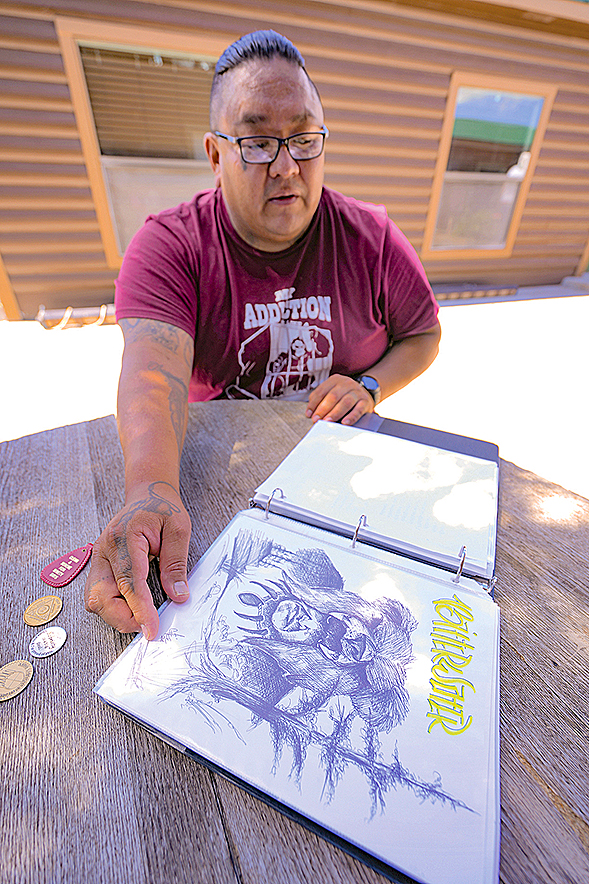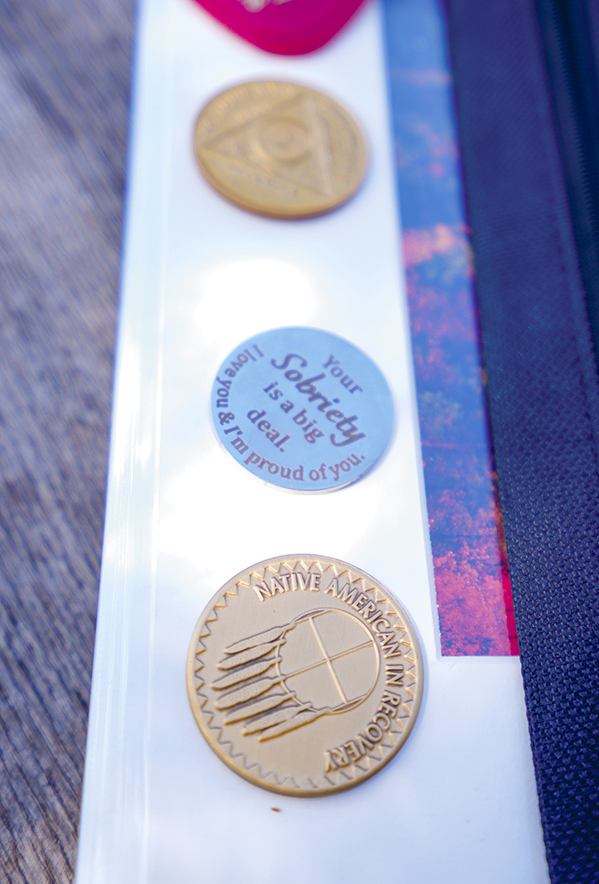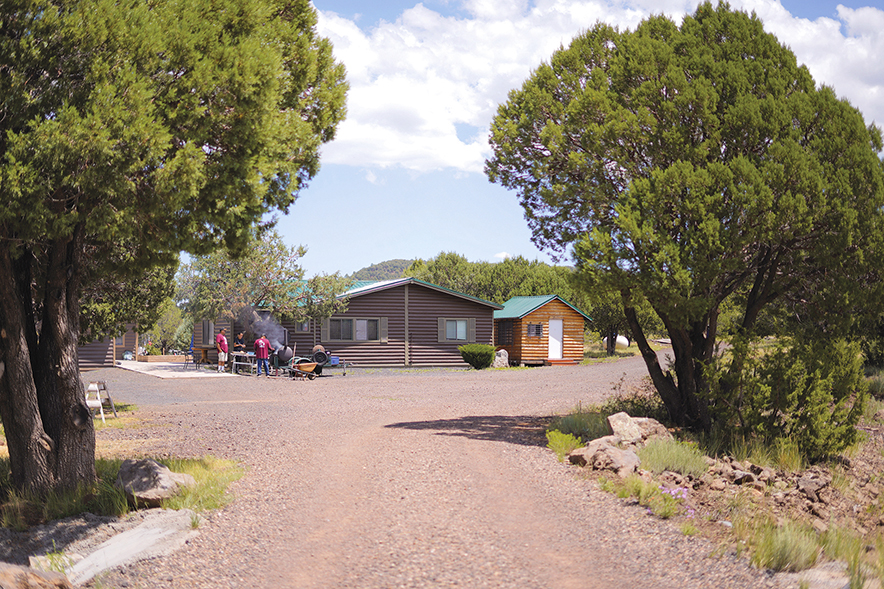
Help is available but still lacking in the Navajo Nation

Special to the Times | Donovan Quintero
Beacon Treatment Center clients in red shirts busy themselves making frybread and hamburgers for lunch on Aug. 15 at the treatment facility in Vernon, Ariz.
By Donovan Quintero
Special to the Times
VERNON, Ariz. — For the downtrodden, a treatment center can become a beacon of light.
But a complex maze that can last years or even decades, stands in the way for the alcohol or drug-addicted person to get to a deciding factor that could save their life.

Special to the Times | Donovan Quintero
Lucas, who only can give his first name to abide Beacon Treatment Center’s confidentiality policy, shares some of his artwork on Aug. 15 in Vernon, Ariz. Lucas said he intends to help others afflicted with addiction in the future.
Even incarceration, which political candidates bolster on every election cycle, doesn’t always work, according to one individual who is in his fourth month of recovery.
Patrick, who only gave his first name to protect his confidentiality while at Beacon Treatment Center in Vernon, Arizona, served time in an Arizona state prison because of his numerous driving under the influence convictions.
He said that while imprisonment is necessary, treatment would be more beneficial.
“I think going to jail doesn’t really help, rehab is better,” said Patrick, who’s been to prison after being caught several times and charged with drinking and driving.
He did say that for rehab to be successful, the person must be honest about wanting help with their addiction.
“It has to be themselves. You can’t make anybody go to go to rehab. It has to be them that want to change. So, you have to be honest with yourself to not do it again,” he said.
For him, he said he started drinking as a teenager. What may have started as weekend high parties, soon turned into jail time for drinking and driving.
“I started taking probably when I was a teenager, and I got that got really bad. I got numerous DUI charges in Gallup, and just went back and forth; kept getting caught and getting bailed,” he shared.
He moved to Phoenix around 1989, where his drinking got worse.
“It got even worse there. Pretty soon I went to prison in 1999. I did four months in Florence, then I got back out and started working again, and still was drinking until in 2003 is when I was charged for driving under the influence,” he said.
He was again sentenced to serve time in prison.
“I got out 2005 I didn’t drink no more,” said Patrick.
Meth in prison
While in prison, he was introduced to a more serious and more addictive drug: meth.
“I started doing it with a friend of mine. He said, ‘Let’s try it.’ Why I went along with it; I don’t know. I thought it was OK,” he said, saying his first meth usage was through a syringe. “That’s when I started doing that, and that, that’s what I think made me addicted more and wanting to do that.”

Special to the Times | Donovan Quintero
Lucas, who only can give his first name to abide Beacon Treatment Center’s confidentiality policy, shares some of the sobriety coins he’s earned on Aug. 15, at the Beacon Treatment Center in Vernon, Ariz.
He continued using it after getting out of prison. Soon, his family started noticing he was not doing well and was bringing home the drugs.
“I was bringing it back to the house. Things weren’t working well, and my brother and my mother asked me to go to rehab,” he said.
Years passed and Patrick said he would go into recovery and relapse. But what broke the camel’s back was when he did too much meth, which caused him to hallucinate. He doesn’t remember exactly when his hallucination caused him to start destroying the family home when he believed his mother, sister, and niece were being held hostage under the house.
“I did so much meth, so much slamming down two or three — I don’t know why I did that, I was by myself. I never did it by myself — and it got out of hand, and then I got anxiety, stress, bipolar, and schizophrenic,” Patrick said. “Pretty soon I was so high, I thought I heard people in the mobile home. I got up, took the ax from the closet, and took out the ax. I was thinking, he has my mother and my sister and my niece captive under the house.”
Patrick explained how meth caused him to believe his family was being held, hostage. “So, I got the ax, and I actually hit the mobile home because I was looking for them,” he said.
He didn’t stop destroying the floor when his nephews saw what he was doing.
“My two nephews walking. I could see their eyes. I will never know. I should have stopped. I guess I didn’t, I didn’t care,” said Patrick. “And I just kept going, telling them they were holding grandma and your mom and your sister down here. My brother came back. He said, ‘Oh my god, what did you do?’ So, he called the Navajo Police.”
He’s in his fourth month. Patrick said if the Navajo Nation had a rehabilitation to help him, he most likely would have gone there, but the tribe has none he said.
“They have to understand that to fund that rehab, not just say, ‘Just give them another mountain and give them a big mountain,’ then take half of it, because it’s what they do,” Patrick conjectured of how the tribal government operates when it comes to how it funds programs. “Stop stealing from your people. That’s what it is. And we can have the rehab, a nice place like this. I do want to go to do a rehab on the reservation.”
Holistic approach
The Navajo Division of Behavioral Mental Health Services, or DBMHS, according to its website, is committed to supporting the mental health and well-being of the Navajo people through a holistic approach. It offers a variety of services, DBMHS provides assessments, outpatient and residential treatment, individual and group therapy, crisis intervention, and after-care services. What sets DBMHS apart are its cultural and spiritual offerings, including traditional ceremonies and faith-based practices led by local practitioners.
Additionally, the Navajo Regional Behavioral Health Authority delivers essential case management for individuals facing serious mental illnesses. Its primary focus is on outpatient mental health and substance abuse care for all ages, alongside outreach programs aimed at suicide and substance use prevention.
With nine outpatient treatment centers located across Arizona, in towns such as Chinle and Tuba City, and two additional centers in New Mexico, DBMHS is readily accessible. The organization fosters community coalitions, educates the public on mental health issues, and promotes awareness of suicide risk factors.
Decline in substance abuse treatments
In 2022, the United States witnessed a noticeable decline in substance abuse treatment facilities, with the total number falling to 17,353—down from 18,615 in the previous year. This statistic highlights a concerning trend in the availability of care for individuals battling addiction, as reported by Statista, a leading global data and business intelligence platform.

Special to the Times | Donovan Quintero
Beacon Treatment Center clients busy themselves making frybread and hamburgers for lunch on Aug. 15 at the treatment facility in Vernon, Ariz.
The reduction in treatment facilities comes at a time when the need for these services remains critical. Data from 2020 shows that states like Arizona had 447 treatment facilities, New Mexico housed 162, and Utah had 333. These figures indicate the ongoing struggle with substance abuse across the country, especially in regions where addiction issues are prevalent.
According to the Navajo Epidemiology Center, recent statistics reveal troubling trends in hospitalization rates related to substance abuse. Males consistently demonstrate higher hospitalization rates than females for alcohol poisoning. Alcoholic liver disease emerged as one of the leading causes of hospitalization for both genders in the Navajo Nation in 2021. While hospitalizations for alcohol poisoning saw a significant decrease in 2020 compared to 2019, this positive trend was followed by a slight increase in 2021, suggesting a resurgence of alcohol-related health crises.
Opioid issues increasing
The opioid crisis also remains a pressing concern, with hospitalizations for opioid-related issues increasing in 2021. This uptick marked a notable change, as there were no substantial variations in opioid-related hospitalizations in the years prior—2019 and 2020.
The implications of these statistics are profound. The reduction in treatment facilities coupled with rising hospitalization rates may indicate a gap in accessible care for those in need. Experts warn that without adequate treatment options, individuals struggling with addiction may be forced to navigate their recovery journeys without the necessary support.
Myron Eriacho, who is an outreach specialist and facilitator at Beacon Treatment Center, said the truth regarding treatment centers on the tribal lands is that “there are few and none at all.”
“This is from my personal travels and having many conversations with a variety of incidentals who work with BHS (Behavioral Health Services), courts, probation, hospitals, and clinics,” he explained. “In particular for the female population. The question that is asked of me is, ‘Do you have a treatment center for women?’ It’s a need, a vital need. There are not enough in Indian country.”
Eriacho facilitates talking circles and sweat lodge ceremonies for the male clients at the Beacon Treatment Center. In addition, he travels throughout New Mexico and Arizona doing outreach in the reservations he visits.
While his passion is unquestionable, Eriacho acknowledges that someone who wants sobriety has to want it for themselves.
“It is vitally important that the male client in Beacon’s (Treatment Center) case find their self-identity and most important their spirituality. What is your spiritual essence? Who are you? Where do you come from? Who are your Ancestors? What clans do you belong to and what are your tribal roles and responsibilities within the tribe?” Eriacho asked as he explained the importance of admission and then worked on reconnecting with their spirituality. “Addiction is a spiritual sickness because an individual loses some if not all the above-mentioned self-identity. Spiritual illness equals a spiritual solution. Individuals can find this with their understanding of a power greater than oneself. No human power can heal you but, for sure without a doubt, the Creator, God, will perform the miracle. Making a relationship with one’s maker is a personal journey. No two are alike. Recovery and sobriety make that possible.”
Recovery services
Currently, Chinle Day at a Time Club, or DAATC, provides alcoholic anonymous, Alanon, and well-briety recovery meetings for the community. The club also has walk-in clients who seek assistance in obtaining recovery services. The club provides peer support services that can range from 255-632 people per month, according to Chinle Chapter President Rosanna Jumbo-Fitch.
“The DAATC has been providing critical services to the communities and chapter members with great achievements,” said Jumbo-Fitch. “The following services have been helping our Navajo people for several years and they have passionate individuals who have had a positive impact on people life’s and guided them to sobriety and assisted them with full recovery.”
The DAATC field offices carry out several different programs such as Support Groups (Alcoholics Anonymous, 12 steps & Traditional Meditation), Spiritual Awakening – Diné Bizaad, Family Counseling & Therapy, Traditional Sweat, and Substance Abuse Education.
Jumbo-Fitch said the 24th Navajo Nation Council allocated funding through legislation for $250,000 to the DAATC organization at Chinle for their renovation project.
With the allocation, DAATC is proposing to apply a portion of those funds to relocate and renovate a double-wide trailer that was donated to the organization. It will allow the organization to continue providing service to the community. By acquiring the trailer, it will provide DAATC additional alcohol and substance abuse prevention activities, treatment, counseling, and services to the Chinle and surrounding communities that will include integrating cultural traditional, and faith-based services as tools to remedy the problem of alcohol and substance abuse.
Patrick has two more months before he completes his program. He doesn’t speak much about what’s next for him. He does suggest that if someone speaks to the Navajo youth about the dangers of using drugs or alcohol, that person should be someone who speaks from real-life experience.
“Probably a person that has gone through it, through addiction and addiction. But it has to be the person being able to talk about what it does to you — ‘Don’t try this, this is bad’ — being able to talk to them about that,” Patrick advised. “And tell them like your life story. And then just tell them the truth, what you went through.”
For him, his experience with alcohol and drugs led to prison time and scaring his family when he destroyed their home during a meth-induced hallucination, and how he first experimented with meth through a friend.
“I don’t know why I started doing it by myself. There’s like bipolar, hearing things that weren’t there, being schizophrenic, being scared, thinking someone’s after you, anxiety, stress, hatred, bitterness, and guilt, all in one. It’s like a monster watching you, talking to you, and it’s all made up, and you think it’s real. That’s because it does that to you. This is what it did to me,” he said.
For anyone needing help with their alcohol or drug problems, can call Tséhootsooí Medical Center at 928-729-8000, Nahat’á’ Dziil Health Center at 928-688-5600, Gallup Indian Medical Center at 505-722-1000, Crownpoint Health Care Facility at 505-786-5291, Sage Memorial Hospital at 928-755-4500, Chinle Comprehensive Health Care Facility at 928-674-7001, Winslow Indian Health Care Clinic at 928-289-4646, Tuba City Regional Health Care Corp at 866-976-5941, Kayenta Health Center at 928- 697-4000, Inscription House Health Center at 928-672-3000, Northern Navajo Medical Center at 505-368-6001, Four Corners Regional Health Center at 928-656-5000, Dził Ná’oodiłii Health Center at 505-960-1801, Chinle Comprehensive Health Care at (928) 722-1000, or Dilkon Field Clinic at 928-657-3800, or Beacon Treatment Center at 928-251-2785.








 Highway 264,
Highway 264, I-40, WB @ Winslow
I-40, WB @ Winslow